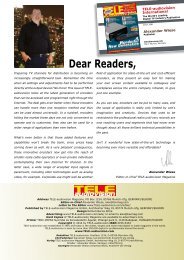eng TELE-audiovision 1305
The World’s Largest Digital TV Trade Magazine
The World’s Largest Digital TV Trade Magazine
You also want an ePaper? Increase the reach of your titles
YUMPU automatically turns print PDFs into web optimized ePapers that Google loves.
FEATURE Self-made IpTv<br />
Vitor Martins Augusto<br />
It’s actually quite normal<br />
to use Coax cable to<br />
distribute digital TV signals<br />
to a TV; it doesn’t<br />
matter if it’s a satellite<br />
signal from an LNb, a terrestrial<br />
signal or a cable<br />
signal. This method of<br />
distribution has one disadvantage:<br />
a coax cable<br />
must be routed to each<br />
and every TV and for<br />
each TV a matching receiver<br />
for digital signals<br />
is needed.<br />
An alternative to this is<br />
IPTV. It has been available<br />
for quite some time<br />
now but up until now it<br />
has only rarely been used<br />
in a private setting.<br />
With IPTV, digital signals<br />
are distributed via a computer<br />
network. Data is sent<br />
in small packets whereby<br />
the various network adapters<br />
are connected to a<br />
switch. The purpose of this<br />
switch is to route the data<br />
packets from a broadcaster<br />
to the attached TVs. A<br />
switch handles this task in<br />
an intelligent way; it routes<br />
the data packet to only one<br />
TV. To that end, all of the attached<br />
TVs have to link to<br />
the switch.<br />
Although most of the<br />
switches used in the private<br />
setting come with only 4 to<br />
16 inputs, more than one<br />
switch can be connected in<br />
series. In this way up to 254<br />
receivers can be provided<br />
for (actually, the identification<br />
numbers 0 – 255 are<br />
available although they are<br />
usually reserved for special<br />
uses). The group of up to<br />
254 receivers forms a subnet.<br />
If a broadcaster’s data<br />
packet in one subnet is to<br />
be routed to a TV in another<br />
subnet, then a router would<br />
1<br />
2<br />
be needed. A router handles<br />
the communications<br />
between different subnets.<br />
Private users, for example,<br />
use a router to access the<br />
Internet so that the computer<br />
in the home network<br />
(that itself forms a subnet)<br />
120 <strong>TELE</strong>-<strong>audiovision</strong> International — The World‘s Largest Digital TV Trade Magazine — 05-06/2013 — www.<strong>TELE</strong>-<strong>audiovision</strong>.com<br />
1. open the Ip address of your Linux receiver in the Firefox browser.<br />
Depending on the installed firmware, a receiver’s web frontend<br />
should open in which you can, among other things, have a look at<br />
the EpG of various channels. In most cases you’ll see a small Tv<br />
symbol on the right side. click on it.<br />
2. Either VLC will open directly or you’ll be given a file to download.<br />
Open the file in VLC so that the desired channel will be streamed in<br />
its original picture quality to your pc. That’s how simple IpTv can<br />
be even with this huge limitation: only one can receive the stream<br />
on their Tv.


















